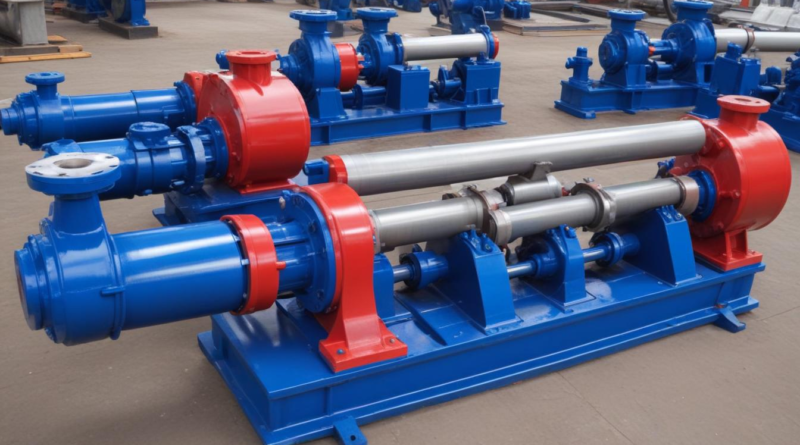Differences between single and double progressive cavity pumps
The design and construction of progressive cavity pumps play a crucial role in determining their functionality and suitability for various applications. A significant difference lies in the configuration of the rotor and stator. In a single progressive cavity pump, the pump consists of one helical rotor that rotates within a single helical stator. This simple arrangement allows for smooth flow and minimal pulsation, making it ideal for applications requiring a steady output. Conversely, a double progressive cavity pump features two rotors and stators, resulting in a more complex system that can handle higher pressures and viscosities. This design is particularly beneficial in applications involving thick, heavy fluids where enhanced flow stability and the ability to generate higher discharge pressures are necessary.
Furthermore, the materials used in the construction of these pumps can vary significantly. Single pumps typically utilize standard materials that suit a variety of fluid types, while double pumps may require specialized alloys or coatings to withstand harsher operating conditions. The addition of a second rotor and stator in double pumps increases the overall weight and complexity of the unit, impacting installation and maintenance considerations.
When analyzing the performance characteristics, the flow rates of single and double progressive cavity pumps differ substantially due to their design. Single pumps are generally more compact and can be installed in tighter spaces, whereas double pumps offer superior capabilities for large-scale operations needing higher flow rates and pressure. Choosing between these two types should take into account the specific application requirements, including fluid properties and delivery needs.
Applications of single and double progressive cavity pumps
Applications for single and double progressive cavity pumps vary widely across industries due to their unique design features and operational capabilities. Single progressive cavity pumps are often employed in sectors where low to moderate viscosity fluids are being handled. Common applications include wastewater treatment, where they efficiently convey sludge and other viscous materials, and in food processing, where the gentle pumping action minimizes shear forces on sensitive liquids like yogurt or fruit purees.
In the oil and gas industry, single progressive cavity pumps are frequently utilized for oil extraction and chemical injection. Their ability to handle varying flow rates while maintaining consistent pressure makes them ideal for wellhead applications. Additionally, they find use in industrial applications for moving paints, coatings, and adhesives, which often exhibit non-Newtonian flow characteristics.
On the other hand, double progressive cavity pumps are designed for more demanding applications where higher pressures and viscosities are encountered. These pumps excel in heavy industry, where the transportation of thick slurries is common, such as in mining and construction. For example, double pumps are particularly effective in transferring cement mixtures and mineral slurries due to their superior ability to maintain flow stability under pressure.
Moreover, double progressive cavity pumps have significant applications in the chemical processing industry for handling viscous polymers and other highly viscous fluids, as they can provide the necessary force to move these challenging materials through complex piping systems. Their robust design also suits them for use in pharmaceutical manufacturing facilities, where maintaining sterility and precise flow control is critical.
In biotechnology, double progressive cavity pumps are employed for applications such as nutrient solutions and fermentation broths, where the ability to maintain a consistent flow rate while handling various fluid characteristics is essential. The versatility of these pumps allows them to be adapted for a wide range of applications, demonstrating their importance across multiple industries. The choice between single and double progressive cavity pumps should be guided by specific application needs, including fluid type, required pressure, and transfer rates.
Performance characteristics of progressive cavity pumps

The performance characteristics of progressive cavity pumps are pivotal in assessing their efficiency and suitability for specific applications. Both single and double progressive cavity pumps exhibit unique performance metrics that distinguish their operational capabilities. One of the primary performance benchmarks is the flow rate, where single pumps generally offer improved efficiency at lower flow demands, making them ideal for conveying fluids with lower viscosity. Their design allows for a smoother operation with reduced pulsation, which is beneficial for installations requiring steady and reliable delivery.
In contrast, double pumps excel in high-flow scenarios, capable of managing significantly thicker fluids and higher pressures. This is due to their robust design, which allows for a greater differential pressure across the pumping mechanism. As a result, double progressive cavity pumps are often employed in high-demand industries where the viscosity of the fluid can vary drastically, necessitating a pump that can maintain consistent performance under challenging conditions.
Another critical performance aspect is efficiency, measured in terms of energy consumption relative to the flow delivered. Single progressive cavity pumps tend to have a higher efficiency in less demanding applications, particularly in systems with lower operating pressures and viscosities. Conversely, while double pumps may consume more energy due to their more complex structure, they provide better performance in high-viscosity or high-pressure applications, where energy is needed to maintain adequate flow rates and overcome friction losses.
The displacement per revolution is another factor to consider when analyzing pump performance. Single progressive cavity pumps generally have lower displacement, making them suited for applications that require precise volumetric delivery over extended periods. Double pumps, with their dual configuration, offer higher displacements, allowing for rapid material transfer in operations where speed is crucial.
Durability is also a key performance indicator related to the type of materials used in the pump construction. Single progressive cavity pumps, regularly made from standard materials, are effective for less abrasive fluids. In contrast, double progressive cavity pumps often use tougher, more resilient materials to prevent wear from abrasive slurries or aggressive chemicals. This durability translates into a longer lifespan and reduced maintenance frequency for double pumps in harsher operating environments.
Fluid handling characteristics should also be considered. Single pumps demonstrate excellent performance with Newtonian fluids, where the viscosity remains constant regardless of the shear rate. Double pumps, however, are preferred for applications involving non-Newtonian fluids, where the viscosity can change based on the flow conditions, reinforcing their versatility in a broader range of industrial applications.
Accordingly, when selecting between single and double progressive cavity pumps, it’s essential to evaluate the specific requirements of the application, including pressure levels, fluid properties, and the desired flow rates. Understanding these performance characteristics will aid in making informed decisions that align with operational efficiency and cost-effectiveness.
Maintenance requirements for single versus double pumps
The maintenance requirements for single and double progressive cavity pumps differ significantly due to their distinct designs and operational complexities. Regular maintenance is essential for ensuring optimal performance and longevity of both types of pumps, but the specific actions required can vary.
For single progressive cavity pumps, maintenance routines tend to be less demanding. Key maintenance tasks typically include:
- Visual inspections: Regular checking for leaks, wear, and other anomalies in the external components.
- Lubrication: Ensuring that the rotor and stator are properly lubricated to minimize friction wear.
- Seal replacement: Periodically replacing seals to prevent leaks and maintain efficiency.
- Fluid level checks: Monitoring the fluid level to avoid cavitation and ensure consistent operation.
These maintenance tasks can often be performed quickly and with basic tools, making single pumps more accessible for routine upkeep in less demanding operational contexts.
In contrast, double progressive cavity pumps require more comprehensive maintenance strategies. They are typically subjected to higher pressures and operate in more demanding environments, necessitating a more rigorous maintenance approach. Important maintenance aspects include:
- Thorough inspections: Detailed assessments of both rotors and stators are crucial to detect any signs of wear or damage, especially in high-stress applications.
- Alignment checks: Ensuring correct alignment of the dual rotor and stator components to avoid uneven wear or operational inefficiencies.
- Regular calibration: Fine-tuning the pump settings to maintain optimal performance as operating conditions change.
- Component replacement: Replacing or repairing components affected by wear and tear, which may include bearings, seals, and rotary joints.
The increased complexity of double pumps means that maintenance often requires more specialized knowledge or training. Technicians may need to follow specific manufacturer guidelines or use specialized tools to safely and effectively perform maintenance tasks.
Cost considerations are also significant when comparing maintenance requirements. While single progressive cavity pumps might incur lower maintenance costs due to their straightforward upkeep, double pumps may demand a higher initial investment in maintenance skills and tools but can ultimately deliver better reliability in high-demand applications.
In summary, the maintenance needs of progressive cavity pumps are closely tied to their design and intended application. Understanding these maintenance differences is essential for effectively managing the operational efficiency and lifespan of both single and double pumps.
Cost considerations and economic factors

When evaluating the cost considerations associated with single and double progressive cavity pumps, various economic factors come into play, which can impact not only the initial purchase price but also the long-term operating and maintenance expenses. Understanding these financial implications is crucial for engineers and users in their selection process.
Initially, the cost of acquisition is often higher for double progressive cavity pumps due to their complex design and greater material requirements. The dual rotor and stator configuration necessitates advanced engineering and manufacturing processes, which contribute to their increased price point compared to single pumps. When assessing initial costs, it is important to also consider factors such as:
- Material quality: Double pumps often utilize specialized materials to withstand harsher operating conditions, impacting their cost.
- Performance range: The ability of double pumps to handle higher pressures and viscosities may justify their price in specific applications.
- Market factors: Prices can vary based on manufacturer, region, and demand for specific pump types.
In terms of operational expenses, the efficiency of the pump plays a significant role. Single progressive cavity pumps, typically designed for lower flow rates and pressures, may show lower energy costs in applications where energy consumption is a significant factor. However, for high-pressure or high-viscosity applications, double pumps may prove more economical over time due to their ability to maintain performance and reduce the need for multiple pump units.
Long-term maintenance costs also differ significantly between the two types. While single pumps have simpler maintenance protocols, leading to lower direct costs, they may require more frequent servicing in applications that demand consistent output. On the other hand, double pumps may have higher maintenance costs due to their complexity but can offer increased reliability and reduced downtime, resulting in overall cost savings in high-demand situations.
When analyzing cost-effectiveness, it is essential to consider the following:
- Life cycle cost: The total cost of ownership for single and double progressive cavity pumps must include purchase price, energy use, maintenance, and potential downtime.
- Return on investment: Assessing how the selection of one pump type over another aligns with operational goals and whether performance improvements justify additional investments.
- Fluid handling characteristics: Ensure the pump type chosen is ideally suited for the specific fluid conditions to optimize performance and cost-effectiveness.
Ultimately, the decision between single and double progressive cavity pumps involves a multifaceted analysis of not only immediate costs but also long-term implications on performance and maintenance. By carefully considering these economic factors, engineers and pump users can make informed decisions that lead to improved efficiency and cost savings in their operations.


